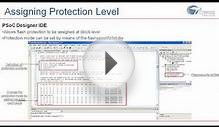The semiconductor industry is one of the most R&D intensive industries where 15 to 20% of sales are spent. Most modern semiconductor products are complex devices which require a series of complicated steps to manufacture. Innovations take place over a large range of technologies, being it materials, electrical properties, electronic circuitry, manufacturing or applications. The semiconductor industry is global and highly competitive. In such an environment Intellectual Property Rights (IPR) are essential to protect innovations and to ascertain that newly developed technology can be kept proprietary and, if desired, be exchanged against an appropriate compensation.
Accordingly, for the semiconductor industry it is essential that procedures for the grant and enforcement of patents are of good quality, efficient and predictive. ESIA promotes the harmonization of procedures and patentability criteria to achieve this goal and emphasizes the need for patent offices to work together to increase the quality of the patent grant procedures.
Patent system in Europe
In Europe, the patent system is fragmented and expensive. The costs for obtaining and maintaining patent coverage in some parts of Europe are much higher than in the US or China. While the European Patent Office (EPO) provides for a single, high quality, grant procedure, patent enforcement is a national matter with different procedures and requirement in each country. Effective patent enforcement in multiple countries in Europe is costly and burdensome and may lead to different outcomes in different countries. Despite that, in Europe important innovation in semiconductor R&D takes place, the fragmented, expensive and burdensome patent system has as a consequence that innovations made in Europe are often not well protected there. Products using innovations originating from Europe can be put on the market in large parts of Europe without compensation to the innovative company or research institute. ESIA believes that this harms the position of Europe as a location for innovation as well as the value of European companies (Intangible assets, a/o patent, are estimated to represent about 80% of the value of knowledge intensive companies).
ESIA considers that the procedural costs for obtaining a patent within EPO are too high and, therefore, strongly supports the idea of establishing and implementing the Unified Patent Court (UPC).
Trademarks
Patent are not the only IP rights of concern to the semiconductor industry. Trademarks define the origin of a product and form the legal basis for fighting counterfeit products. ESIA supports efforts to stimulate that registered trademarks provide protection not only for literal use but also for similar use in the same field.
Counterfeits
Counterfeiting is often linked with trademark infringement. It not only erodes the economic basis of the companies that have invested in new products but also are not subject to the same quality requirements, leading to substandard products in the supply chain of our customers. ESIA believes that effective and efficient procedures to stop counterfeit products in Europe are important, but at least as important is to make arrangements with the authorities in the countries that are the source of counterfeit products to stop the manufacture and sale.
Trade Secrets
As a very knowledge intensive industry, only a small part of the technology developed is suitable to be protected by patents. Sufficient protection of trade secrets must be possible. In Europe trade secrets are governed at a national level, mainly in the area of unfair competition. ESIA feels that a uniform approach is highly desirable in which trade secrets are treated as a form of intellectual property.
For a better protection of trade secrets in Europe
Companies develop confidential information that provides a competitive advantage. This information includes manufacturing techniques, chemical formulae, product design, technical data, as well as customer lists, business leads, marketing strategies, pricing schedules, and sales techniques.
In the present Information Age documents can be copied and send around at virtually no effort and cost. This increases the difficulty that firms encounter in maintaining the confidentiality of any valuable information. In our increasingly global, connected world, protecting trade secrets is more and more challenging. As the physical limitations to distribution of information have disappeared, it is vital that strong legal tools become available to EU companies to achieve and maintain competitive advantage through investment in innovation.
With the increased reliance upon technological advances and innovation, the theft of know-how, or trade secrets, is presently damaging many industries, among which the semiconductor industry. European companies are confronted with:
- The taking of valuable proprietary information, which invariably leads to harm to their business, innovation strategy and R&D efforts
- The marketing and sale of products made after theft of know-how, which often leads to products that are tainted and of inferior quality and might, in some cases, present a danger to the public health and environment
- Products created as a result of such thefts, which compete unfairly with the original product because they do not bear the burden of the costs of innovative efforts
Infringing products that are manufactured as a result of theft are only able to compete with the genuine product because they incorporate the stolen know-how. Without such know-how, the infringing manufacturer would either not be able to produce his product or would not be able to produce a product that offers the same characteristics or properties as the genuine article.
RELATED VIDEO
